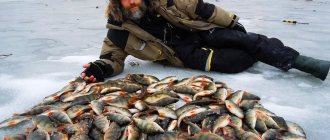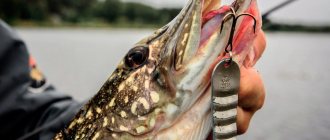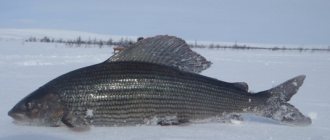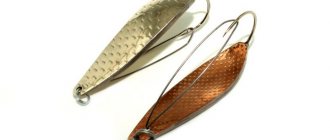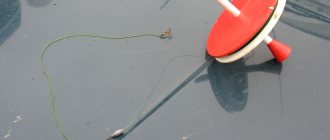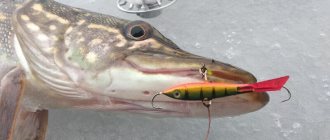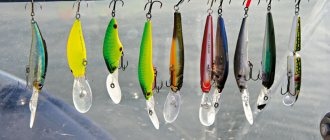Did you know that, according to many experienced fishermen, it is believed that catching perch with a lure in winter is a real pleasure. Both the process itself and the result are interesting. In general, perch is considered a predatory fish that is not picky about its habitat, so it lives in all bodies of water and remains active all year round. But, I want to tell you that catching him is not an easy task. It is important to take into account all the rules of fishing and “get your hands on it.” Then you are guaranteed success.
Sit back comfortably, it will be interesting with us.
How to catch big bass in winter
This question interests any avid fisherman. After all, catching large perch in winter is an interesting hobby for anglers. Of course, any perch will be to your liking, but when you catch a large predator, and this is from 1-1.5 kg in weight, the sensations and emotions are completely different.
The first step in catching large perch is to find its habitat. More often they swim in large lakes and reservoirs. They also happen in small bodies of water, but you will have to spend more time searching for places. The deeper you go from the shore, the greater your chances of catching a heavyweight. At a minimum, you need to go half a kilometer or more.
The second step will be drilling holes in a checkerboard pattern. It is recommended to make about 10-20 of them. At the same time, the distance between them must be at least 5 meters.
Third step: all holes must be stocked with fish food. As a rule, this is a bloodworm or jig. Ideally, both. This is done for more efficient fishing. You can alternate the holes and lightly sprinkle them, for example, 1 - bloodworm, 2 - jig, 3 - bloodworm, etc. This way you will understand what kind of bait the fish bit on today. And you will already know what to feed next for a successful catch.
Secrets and nuances
There are still some points that should be applied when flashing in winter. Perhaps after mastering the wiring technique. If it works out, then you can do it right away.
- When winter fishing on a sunny day (especially in shallow water), the holes are covered with snow (or the sludge is not completely removed). Use the handle of a spoon to make a small hole in the ice crumbs, and drop the spoon there. Sometimes a perch is frightened by a column of light in a dark background. It is especially important not to flicker between the sun and the hole (not to create sudden changes in illumination), this scares not only the perch, but any fish in general.
- Perch is strongly attracted to dregs. There is even a special tackle based on tapping on the bottom - a bulldozer. It is worth using this wiring element more often.
- When fishing for perch in winter, always pay attention to retrofitting the hooks with bright elements. Basically, the perch grabs them, and not the spoon. In this regard, a decorated hanging tee (with a drop), a hook with bristles, as well as various flies or bubbles work well. At great depths in winter, three-pieces with a drop of fluorescent varnish work well, at shallow depths - red, yellow or white.
- Using special perch bait in winter often brings good results.
- There is an opinion that in winter, closer to spawning, perch is reluctant to take large baits, since its abdominal cavity is filled with caviar or milk, preferring jigs or micro-spinners.
- When fishing with spoons, you can attach bloodworms, maggots or pieces of fish to the hanging hooks of the rig. During periods of low biting in winter, this action can bring a significant catch.
Video:
Which bait to choose
Usually, with the onset of winter, fishermen are in a state of waiting for the water bodies to cover with ice, so that, having collected all the accessories for quality fishing: drill, bait, tackle, fishing box, etc., they can hit the road.
Hunting for a predator can be called a game of chance, because you need to be dexterous, fast and at the same time diligent, patient and good at using a spinner, which has many advantages:
- ideal solution for viewing a winter pond;
- the spinner, due to its mass, quickly sinks to the bottom, unlike a jig;
- does not depend on weather conditions, so you can easily provoke the perch to “play”;
“Experienced” fishermen have a good command of the technique of catching perch in winter using spoons, so they confidently take with them three fishing rods with different parameters:
- first of all, a large bait is used to attract a school of fish;
- if there is no result, then use a smaller spoon with an almost invisible fishing line.
Search and catch
The basis of successful striped fishing is search. You need to find this fish, and only then try to catch it using a variety of gear and techniques. This requires a systematic approach that takes into account many variables. Algorithm of actions:
- Strategic choice of place, time and specific body of water. Sometimes this factor is missed, and it is not always possible to plan a fishing trip. This group also includes the influence of weather on the perch bite in a particular body of water.
- Finding striped fish in a pond and tactics.
- Actions depending on what the initial search led to.
- Direct fishing technique.
- Using a set of gear for different conditions.
Gear selection
Of course, if a beginner goes fishing, then, theoretically, he can take everything as written in the books, but in practice, the main attributes of trolling perch in winter will be:
- a rod 25-35 cm long. The main criterion here is rigidity and a removable reel for storing fishing line.
- fishing line, the thickness of which depends on the mass of the predator.
For light prey, for example, 250-500 grams, you will need a fishing line 0.1 mm thick; for larger weights, the fishing line should be thicker. It is worth understanding that in cold weather ordinary braided line can break, so it is recommended to take monofilament fishing line.
- The nod gives a signal that a fish is biting on the fishing rod.
In theory, there is no particular need for it in winter fishing for perch, unless of course you are a beginner for whom it is important to understand whether the fish is biting or not. The nod is useful in the case of a rigid fishing rod, which, as a rule, is installed to catch large fish, but in fact the “light” ones are caught.
For winter fishing, it is advisable to install the nod at an angle of 20 degrees, and the length itself should not exceed 7 cm. I would like to note that fishing pros do not recommend using lures of bright colors: red, burgundy. Since this can cause a lack of biting or is minimized.
- Hook. The variety of hooks can surprise a novice fisherman. Therefore, it is recommended to take either single or double hooks from the entire range. And you definitely need to pay attention to the point of the tips. Moreover, a lure with a hanging hook can also attract prey.
Specifics of catching pike with lures in winter
An equally important piece of equipment in winter fishing is a spoon. If you treat it correctly, it will show its durability. Most often, anglers use an oscillating-type spinner to catch large or small fish.
Since pike can get off a single hook, it is better to try to use treble hooks.
Note! For winter fishing, when catching pike inactive lures , as well as lures of bright colors.
Fishermen most often use a type of fishing that requires long pauses. To figure this out, you can consider one of several wiring options:
- first you need to lower the spoon to the bottom;
- raise the bait 50 centimeters;
- pause for 5 seconds;
- then smoothly, without sudden movements, lower the spoon into the pond.
This wiring is done about 3 times, and if there is no bite, move on to the next hole.
By the way! When fishing, you should make approximately 10 holes at a distance of 7 meters from each other in order to fish most of the reservoir.
Many have noticed that when fishing, the predator strongly resists, and the force of the jerks is so great that it is proportional to the weight of the fish. The pike also tries to bite the cord or wind the fishing line around a snag. To avoid this, the fisherman should absorb the shocks of the fish, and to do this he must lower the fishing line and carefully guide the caught toothy predator to the hole. They fish it out with a hook.
Video: catching pike with a spoon in winter
No less interesting is catching pike in winter using spinning rods and lures, which travel under water in different ways. Most often they are tested at home in a bathtub filled with water. The following artificial baits are distinguished:
- vertical spinners are a kind of sausage. They glide freely in the water, somersault and swim away to the side. Using experiments, the game of the bait is determined. Light models of such baits are used in shallow waters where there is no current, and heavy models are used in deep waters. The game consists of sharp descents and smooth ascents.
- The tube spoon is made of metal and a tee. Thanks to the oblique cuts on the tube, this bait makes such movements in the water that make the predator attack it. The game is played on the same principle as the spinner.
- balancers. The game with such bait is played on a grand scale, since the tackle works wider and describes eights.
- silicone is usually mounted on a jig or drop-shot method. In the first case, a vibrating tail with a load is attached to the working part of the fishing line, and the game is similar to jig wiring. In another case, they use an end sinker and place the bait higher on the working line. The game is played without lifting off the bottom, and the bait dances in a peculiar way, attracting fish.
- rattlins are a wobbler with a mount in the middle. They are produced in a variety of shapes and shipments for any depth. Most baits are sinking, although some float on the surface. The game is similar to playing with balance beams, and when jerked upward, it vibrates and creates a turbulence in the water, which in turn attracts a predator. In some cases, balls are attached to rattlins to create a rattle effect.
How to shine for perch in winter
To achieve a result, you need to try hard: choose the right winter lures for perch, know all the tricks when fishing, and prepare thoroughly. But don’t be alarmed, every time your fishing skill will improve, experience will appear, and you will start fishing as if it were a game.
Let's talk about what you should pay attention to when buying spinners. Since the variety of assortment can confuse you.
- What is the spinner made of? It doesn't matter here, so don't focus on the material.
- The color of the spinner directly depends on weather conditions. On a clear sunny day, colors of copper and brass shades are used. When it is gray, when the day is cloudy and gloomy, silver lures are used.
- The size of the spoon is selected depending on what kind of perch you plan to catch. For large fish, the optimal length is 10 cm. If the reservoir is deep, then take a spoon no shorter than 8 cm. But for small perch, 5 cm is suitable.
If you still can’t figure out which lure to buy, then in the store a competent salesperson will tell you everything in detail and select it based on your needs. Or you can study the information yourself via the Internet. Fortunately, there are many articles and educational books on this topic. We collected more practical information, verified by the experience of fishermen. Therefore, you can put our recommendations into action.
It's no secret, the variety of spinners is amazing. Let us highlight several models that differ in their quality and functions:
- Smith Pure. He can be called the leader in the list of spinners. Made in Japan. Weighs 2 grams and is up to 2 cm long;
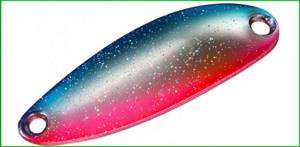
- Rapala Minnow Spoon. The Finnish manufacturer always does the best, so there is no doubt about the quality. The optimal solution for catching perch with a spoon in the winter. Lure weight 7 g, length - 7 cm;
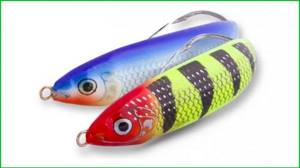
- Rapala SM-Pirken. It is produced in Estonia and is in demand among anglers in the dead of winter, when the perch is most inactive. The length of the product is 2.3 cm and its weight is 2 g;
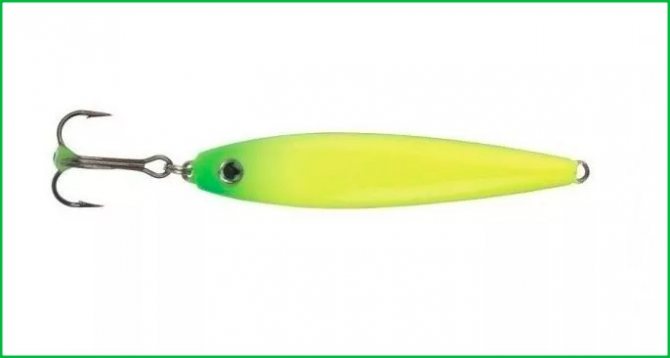
- Russian Bait "Lambada". Bait from Russia. Therefore, it is popular among Russian fishermen. Most often used during the period of perch activation. Suitable for fishing at a depth of 3 m.
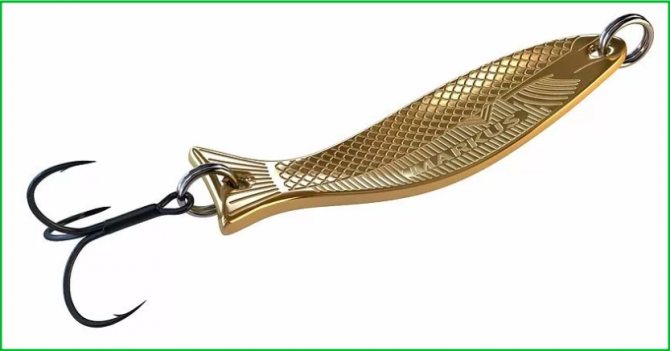
In general, there is plenty to choose from, depending on the needs of the angler and the fishing period. As a last resort, if you are a jack of all trades or are passionate about creating accessories for catching perch yourself, you can make a winter lure yourself from all the materials that can be found in every home. The main thing is to comply with all the parameters of the future product.
Features of wiring with winter lures
Winter spinners differ from their summer varieties in their wiring methods. For the most part, winter fishing with spoons is carried out using vertical methods. After drilling several holes, the angler must determine the depth.
To find out the depth, release the brake on the reel, wait for the spoon to fall to the bottom surface, and raise it about five centimeters above the bottom. Next, you should make throws at different frequencies, forcing the spinner itself to play. In the case when there is no bite, approximately half a meter of fishing line is reeled in and the reel is fixed.
Intensity parameters will depend on winter time. Even at the very beginning of the winter period, it is better to carry out aggressive retrieves and movements of the winter spinner. In the middle of the winter period, you should slightly reduce the intensity of the winter spinner game. And closer to spring, the intensity should be increased again.
How to choose a good time and place for fishing
Choosing the right place for trolling perch in winter is already half the success in achieving the desired result.
When the ice crust reaches its maximum size for the winter period, which is approximately 10-15 cm, fishing becomes the safest. Although some take risks and go fishing already with a thickness of 7 cm. In such conditions, the perch begins to go deeper into reservoirs, looking for places with maximum oxygen availability. Such places include:
- various holes, holes at the bottom of the reservoir;
- slope boundaries;
- reed places;
- rocky surface;
- places where the bottom bends;
- the beginning of rivers;
The weather also greatly influences the successful outcome of fishing. For example, if the weather is sunny and clear, then it’s time to start catching perch. Usually, the result occurs within a day. If, on the contrary, the weather is gloomy, cloudy, without clearing, fishing is reduced to zero. As a rule, the result will be sad, or rather fishless.
Fish activity also depends on weather conditions and fishing time. If you go fishing for perch, decide on the places where this fish likes to live.
In December, when the ice has already become standard “winter” sizes, that is, the thickness has reached 7-8 cm, the fish is still “afloat”. It is in an active state and does not go to the bottom in search of the necessary oxygen. You can find it near the coast or in places with a rocky bottom.
January. This month, the activity of the perch subsides; they are no longer as “hooligan” as in the previous month. The measured habitat and the search for an “oxygen” place make fishing difficult for the fisherman. Here it is important to find “that very fishing spot”.
They are also of little interest in food at this time; they go into “sleep mode.” And in order to somehow stir up the striped “hooligan” and motivate him to attack, you need to try. The optimal time for fishing is morning and a small number of hours after lunch. However, keep in mind that the result will be minimal.
February can be called the month of awakening. The fish sense the approach of spring and begin to “wake up.” At this time they have an excellent appetite. The most optimal time for successful fishing is morning or evening. And the habitats during this period are edges or river beds of melt water.
Of course, winter is fishermen's favorite time of year to catch perch. This period can be called the brightest and most saturated with emotions. It’s not just that you come, cast a fishing rod and sit there. No, every step must be well analyzed and correctly structured.
But don’t forget that winter fishing also has its own characteristics:
- First ice. The most active period is for perch, so the chances of catching a predator are maximum. However, it is worth understanding that sitting at a single hole, it is difficult to achieve the desired result, since the fish during this period are very active and will move underwater at incredible speed. Therefore, it is recommended to make several holes and disguise them with snow so as not to attract the attention of the fish. Don’t be afraid to experiment with bait, try different options for attracting a predator and then you will find the best option for catching perch with a spoon.
- Dead winter. During this period, activity subsides and is replaced by more passive living in water bodies. In cloudy weather or a snowstorm, all attempts to catch our bully are reduced to zero. If you still decide to go fishing, choose the most calm and morning fishing hours. And don’t forget about the spoon, which should be silver in color during this period.
Types of perch spinners
Spoons are classified according to several criteria:
- by type of game;
- by equipment;
- according to the material of manufacture;
- in size.
Animation type
Based on how the spoon behaves underwater, baits are conventionally divided into “studs”, “gliders” and bottom ones. The first sink quickly and deviate little from the vertical axis. As a result, they work better in the following conditions:
- in strong places, for example, in snags;
- by passive predator;
- at great depth.
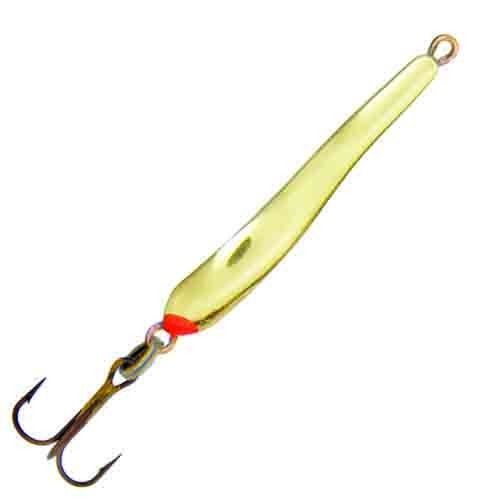
The second type of spinners for catching perch in winter is distinguished by the breadth of its body and sweeping action with a large deviation from the longitudinal axis, akin to a balancer. They are usually called "gliders". They are used in the following places and conditions:
- in clean areas;
- at shallow depths;
- for quickly collecting active perch to the hole.
Bottom spinners work like a bait such as a bulldozer. They are much heavier than others, and play with them in the bottom layer. Often they are only raised from a horizontal to a vertical position without lifting them from the bottom.
READ Wobbler for perch - the best catchable wobblers: video and how to choose a wobbler for the season


